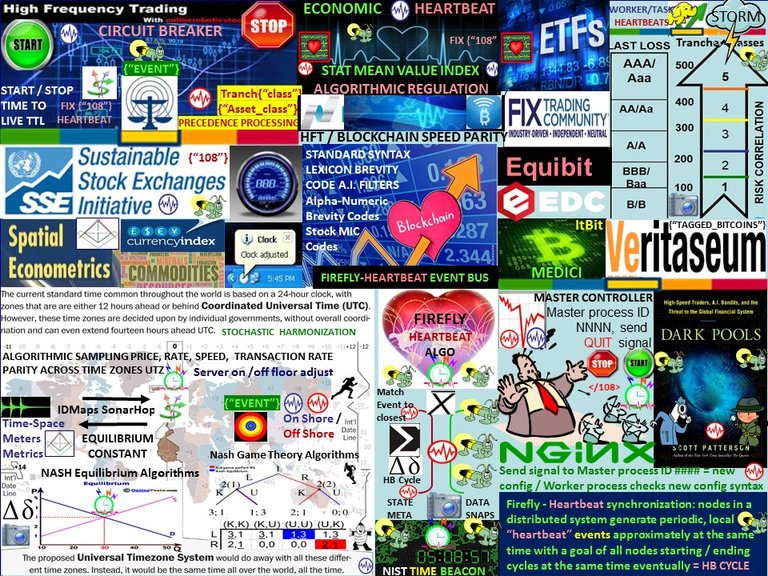
Firefly inspired Heartbeat Algorithm to support a flash trade circuit breaker called for by the World Economic Forum
Algorithms drive markets but do not regulate them = Napoleon @ Waterloo Groundhog's Day
Economist Milton Friedman's k-percent rule Friedman's k-percent rule money supply should be increased by central bank / Treasury by a constant percentage rate every year: N % REAL GDP based on leading economic indicators
LINK: https://en.wikipedia.org/wiki/Friedman's_k-percent_rule
A use case of the firefly inspired heartbeat synchronization algorithm in stock and currency exchanges is algorithmic regulation. For example, improving temporal trade parity between Bitcoin Blockchain & conventional stock exchanges by using the firefly-heartbeat algorithm to take trade speed samples among trade populations across time zones to determine an optimal trade speed / frequency as a statistical mean. Trading velocity far exceeds Bitcoin's current transaction rates estimated to be between 3 - 7 transactions per second and far exceed non-HFT trading capacity. A method is needed to establish temporal trade parity and account for on floor / off floor trading disparity -- enter STAAS Space - Time As A Service using a novel stochastic harmonization algorithm based on the mating behavior of certain species of fireflies that strive to sync during mating activity matched to the closest Operational Tempo OPTEMPO heartbeat cycle.
Wall Street Stock Exchanges must solve the problem where High Frequency Trade transactions far exceed the ability of a regulatory, monitoring 3rd party's (DCCC) ability to record, verify and validate transactions -- a computational job that the Bitcoin Blockchain is being used to solve. Project Medici intends to create a blockchain based securities exchange. “Medici,” the project aims to democratize Wall Street in much the same way bitcoin seeks to democratize currency and payments. By operating separate from traditional stock exchanges and the big corporate banks, it could eliminate certain loopholes in the system and reduce the costs associated with issuing and juggling stock.
All sophisticated algorithms, bots, mots, scripts, agents make use of the heartbeat -- opportunities, intervals, windows in time. High frequency flash trade algorithms are sophisticated and distributed -- however, all algorithms report to a single master controller. The heartbeat = start bit / stop bit, Time To Live = algorithm on / algorithm off / algorithm duration. Heartbeat </108> messages and the heartbeat time cycle can be used to limit trade sessions by trading session or trade time cycle e.g., one trade per cycle and / or n trades per session. Geo-spatial temporal techniques like IDMaps and SonarHop and the firefly heartbeat stochastic harmonization method can be used to account for trades distributed across time zones and trading on the stock exchange floor and off where the length of the fiber optic cable makes a difference in High Frequency Trade volume. Time cycles match Bitcoin blockchain transaction rates currently estimated to be 3 – 7 per second with High Frequency Flash trade rates. Project Lightning's sync delta approach -- sending only the changes to ledgers from one (heartbeat) time cycle to the next instead of refreshing the entire ledger is one solution for trade speed parity.
Economist Milton Friedman's K $ Rule advocates establish an economic periodic pulse representing a countries real GDP. The firefly-heartbeat algorithm could sample time - series databases to arrive at a statistical mean value index comprised of leading economic indicators that would determine currency levels released by the Federal Reserve. A countries currency or FEDCOIN or the World's standard currency Worldcoin could be based on actual values of commodities -- ex: Bitcoin has been deemed a commodity..
Math genius John Nash of Princeton’s equilibrium theorem may be used for stock, currency market equilibrium through use of algorithms to control cartel behavior through sanctions and penalties. The increasing reliance on game theory as a foundation for auctions and electronic commerce, efficient algorithms for computing equilibrium in multiplayer general-sum games are of practical interest for example, in finding a Nash equilibrium for an average-payoff repeated bi-matrix game polynomial-time algorithm. Finite-state equilibrium strategies can be found efficiently and expressed succinctly. Paper: A Polynomial-time Nash Equilibrium Algorithm for Repeated Games: LINK http://bit.ly/1NWeLLu
HADOOP STORM / TRIDENT with real time distributed computation of events at speeds of a million tuples per node per second using worker / task heartbeats to get put instructions for example, to Wall Street high frequency flash trade describing trade window Time To Live TTL and start, stop commands e.g., stop commands to runaway trading sessions.